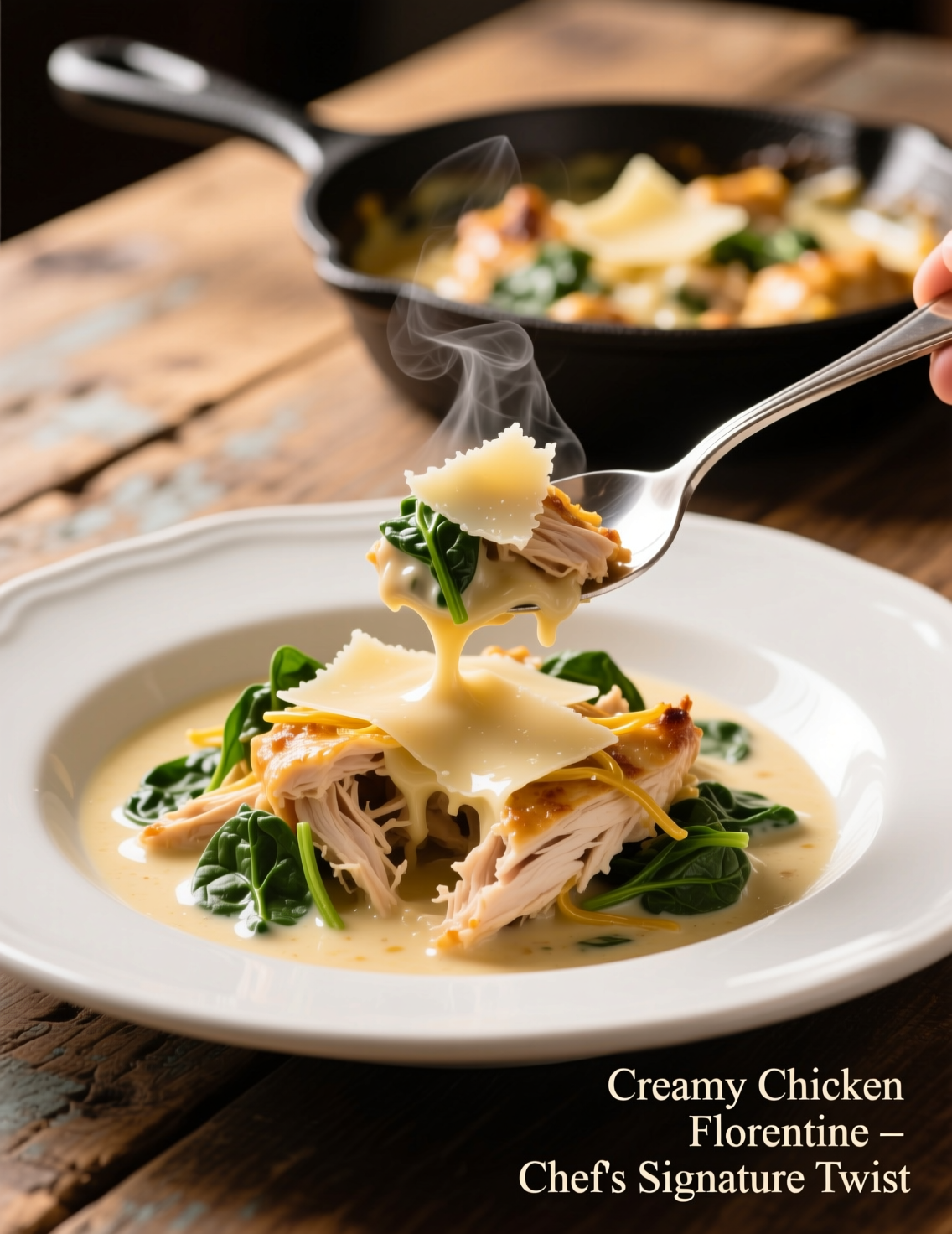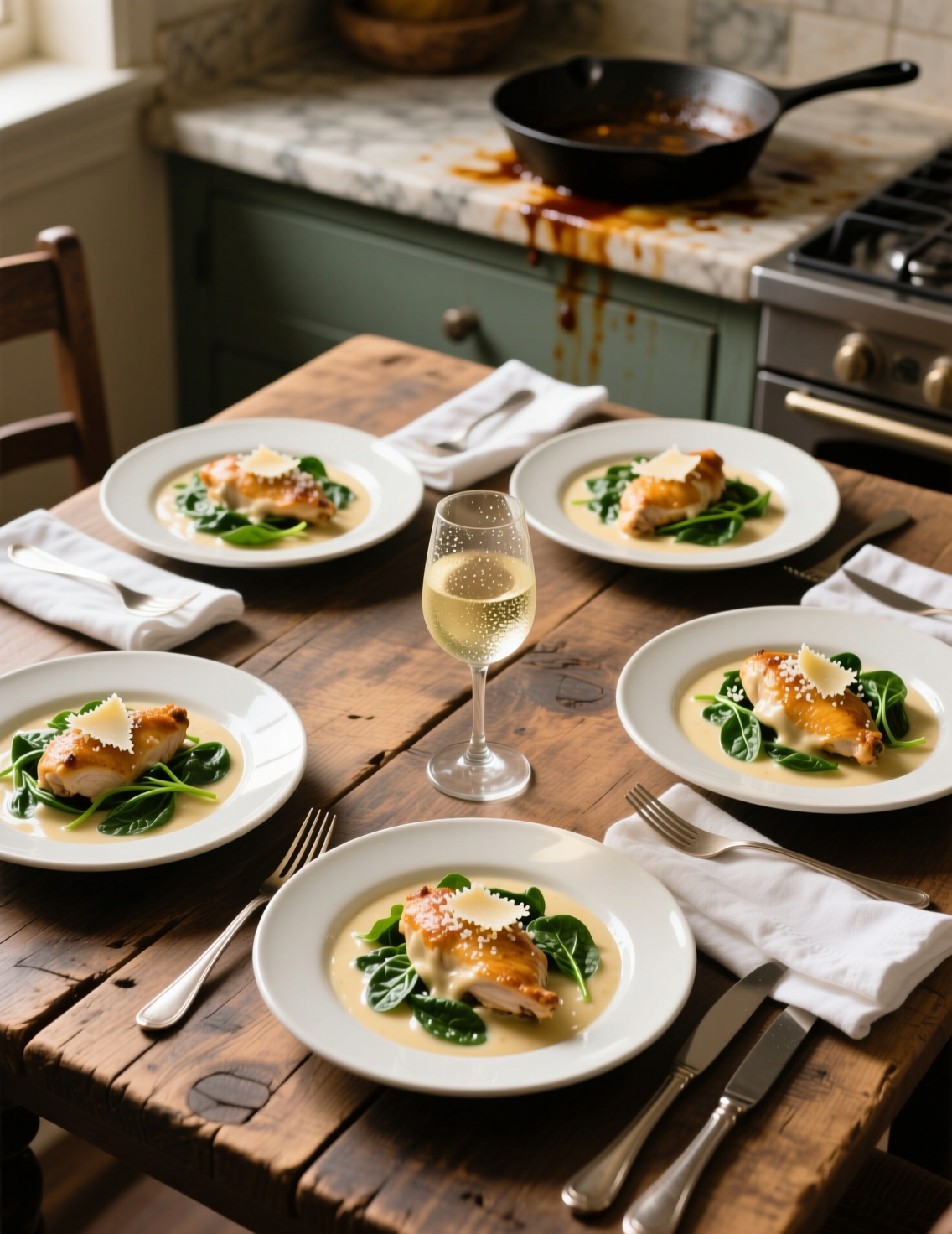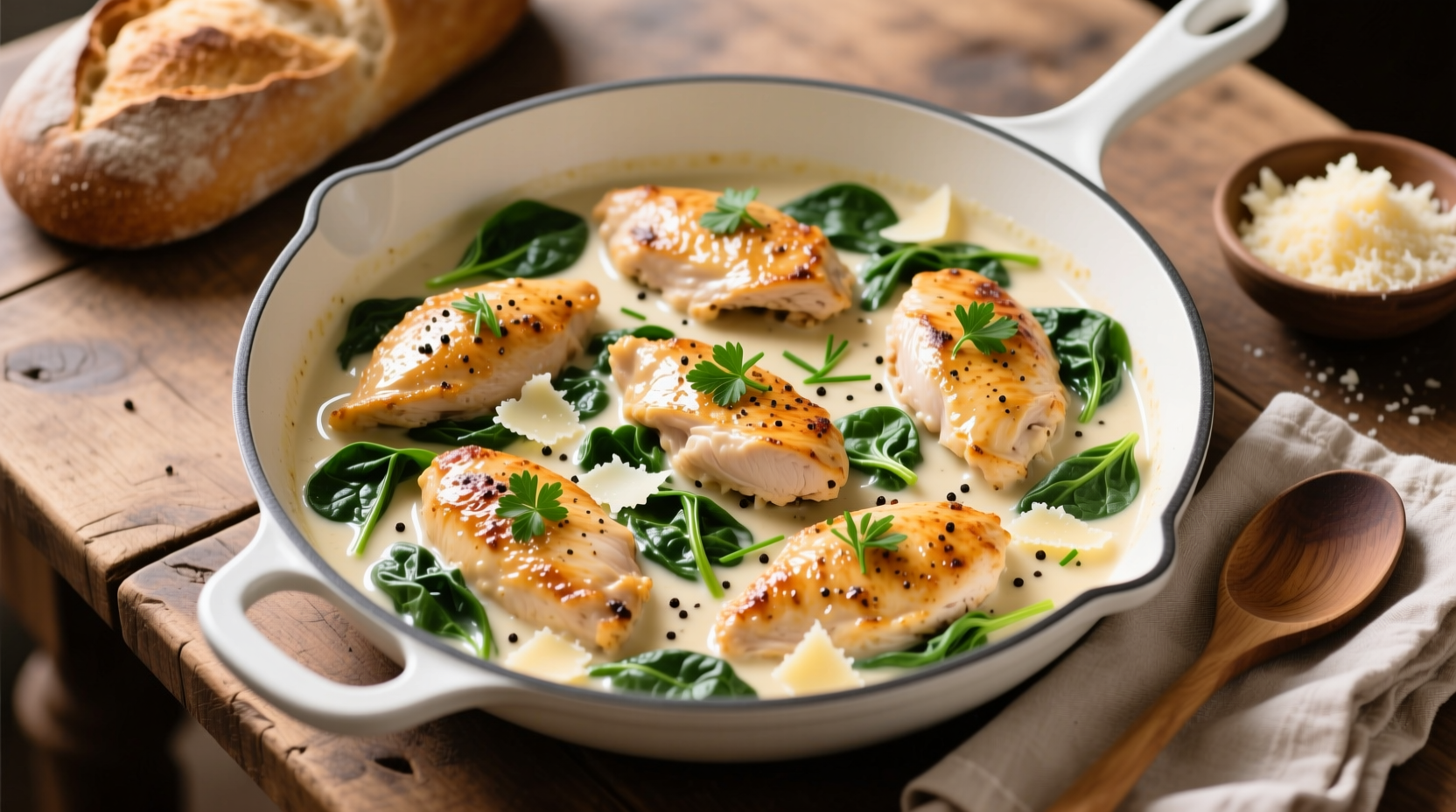If there’s one dish that walks the fine line between comfort and sophistication, it’s Chicken Florentine. You’ve probably seen countless versions online—some too creamy, some too dry, others just missing that Italian spark. But when done right, Chicken Florentine sings. Creamy sauce, tender chicken, and that gentle earthiness of spinach come together like an orchestra warming up to perfection. This isn’t your rushed weekday meal. It’s a quiet, deliberate kind of cooking—where each step matters.
What Exactly Is Chicken Florentine?
The word “Florentine” hails from Florence, Italy—land of art, love, and, apparently, spinach. Anything called à la Florentine almost always includes spinach, butter, and cream. Chicken Florentine, as we know it today, isn’t purely Italian though. It’s more of a Franco-Italian evolution—creamy like a Parisian sauce, earthy like Tuscan greens.
At its core, it’s pan-seared chicken breast smothered in a velvety spinach cream sauce. Elegant enough for dinner parties, yet easy enough to pull off midweek. And when cooked right, it gives off that “restaurant-made” feel without the pretense.
Ingredients You’ll Need (for 6 Servings)
- 6 boneless, skinless chicken breasts
- 2 tablespoons olive oil
- 2 tablespoons unsalted butter
- 4 cloves garlic, minced
- 1 ½ cups heavy cream
- ¾ cup chicken stock
- ½ cup grated Parmesan cheese
- 4 cups fresh baby spinach (loosely packed)
- 1 teaspoon Dijon mustard (optional, but magical)
- Salt and freshly ground black pepper
- A pinch of nutmeg (trust me, it makes it sing)
- Juice of half a lemon
Optional add-ins: sliced mushrooms, sun-dried tomatoes, or a splash of white wine for depth. Professionals often do this quietly—it’s like a secret handshake among chefs.
Prepping the Chicken Like a Pro
Most home cooks skip this part, but pros never do. Before anything else, pat the chicken completely dry. Moisture is the enemy of a good sear. Season generously with salt and pepper. Let it sit for ten minutes at room temperature—helps the fibers relax.
Heat a large skillet (stainless steel or cast iron works best) over medium-high heat. Add olive oil and butter. When the butter foams, that’s your cue. Lay in the chicken, smooth side down. Don’t crowd the pan; do it in batches if needed.
Cook each breast for about 5–6 minutes per side, depending on thickness, until golden brown and just cooked through. Remove and tent with foil. That little rest keeps it juicy, which is where most cooks go wrong—they rush it.

Building the Florentine Sauce
Now comes the heart of it all—the sauce. In the same pan, reduce the heat to medium. Add a touch more butter if needed and sauté minced garlic until fragrant. If you’re using mushrooms or sun-dried tomatoes, this is their moment. Let them brown slightly; that caramelization adds layers of flavor you can’t fake later.
Pour in the chicken stock to deglaze, scraping up those browned bits—what chefs call “fond.” That’s pure gold right there. Add the heavy cream, then stir in Dijon mustard and nutmeg. Let it simmer gently until slightly thickened, about 4–5 minutes.
Stir in grated Parmesan and watch it melt into the sauce. Finally, toss in the spinach. It’ll wilt within seconds, transforming the sauce into a lush, green-speckled blanket of flavor.
A squeeze of lemon juice brightens the whole thing, cutting through the richness. Taste for salt and pepper. Adjust. Then return the chicken to the pan, nestling each piece into the sauce. Simmer for another 3–4 minutes so everything mingles together beautifully.
Expert Insight: The Sauce Ratio Rule
Here’s something many pros know instinctively—the “cream-to-stock” ratio. Too much cream and your sauce clings like glue. Too little, and it feels thin, almost soup-like. For Chicken Florentine, the golden ratio is roughly 2 parts cream to 1 part stock. It gives that perfect nappe consistency—where the sauce coats the back of a spoon without sliding off immediately.
Why Spinach Matters More Than You Think
Most people treat spinach as filler, but it’s the soul of the dish. Fresh baby spinach gives a delicate sweetness that frozen just can’t replicate. Frozen spinach has its place (soufflés, maybe), but in a creamy sauce? Fresh is non-negotiable.
Blanching isn’t necessary here. The cream takes care of the softening. But if you want that deep, vibrant green color, you can sauté it quickly with a touch of butter before adding it in.
The Role of Acidity in Balance
Many chefs overlook this tiny detail. Heavy cream and cheese can dull the palate if unchecked. Lemon juice, or even a splash of dry white wine during deglazing, provides acidity that cuts through the richness. It sharpens flavors, kind of like cleaning the lens on a camera—you suddenly see everything clearer.
If you want to sound fancy, call it “balancing the fat with acid.” If you just want great taste, squeeze the lemon.
Serving Suggestions: Beyond the Basics
Chicken Florentine pairs naturally with starchy companions that can soak up the sauce.
- Buttered pasta: Linguine or fettuccine works like a dream.
- Garlic mashed potatoes: For that stick-to-your-ribs comfort.
- Rice pilaf or risotto: Great if you want an Italian restaurant vibe.
For professionals plating this dish, contrast is key. A white plate, a drizzle of extra sauce, a sprinkle of microgreens. Simple, elegant, intentional.
Pro Tip: Resting Isn’t Optional
Once cooked, never serve immediately. Let the chicken rest in the sauce for 5–10 minutes off the heat. The residual warmth thickens the sauce naturally and allows the proteins in the chicken to reabsorb moisture. It’s the culinary version of letting someone catch their breath.
Nutritional Breakdown (Approximate per Serving)
Calories: 480
Protein: 38g
Fat: 32g
Carbohydrates: 5g
Sodium: 520mg
This is a rich dish—make no mistake. But it’s balanced, not greasy. If you want to lighten it slightly, substitute half the cream with evaporated milk or a lighter cream alternative. Just note: you’ll sacrifice some silkiness.
Troubleshooting Common Mistakes
- Sauce too thin?
Simmer longer. Or whisk in a teaspoon of cornstarch slurry (equal parts water and starch). - Sauce too thick?
Add a splash of stock or milk. Don’t add more cream—it’ll just make it heavier. - Chicken too dry?
You overcooked it. Next time, check with a thermometer—165°F is your friend. - Sauce split or curdled?
You probably added cheese when the pan was too hot. Remove from heat, whisk gently, and add a little cream to bring it back together.

Variations Worth Trying
- Mushroom Chicken Florentine: Sauté 1 cup of cremini mushrooms before deglazing. Adds umami depth.
- Tomato Florentine: Stir in a few sun-dried tomatoes for sweetness and color.
- Low-carb twist: Swap cream for coconut cream and skip the cheese. It’s not classic, but it’s surprisingly rich.
Every chef I know has their own spin on this dish. That’s the beauty of Chicken Florentine—it’s forgiving, adaptable, and endlessly elegant.
Culinary Science Behind the Creaminess
Creaminess isn’t just about fat—it’s about emulsification. When the cream, cheese, and stock are heated together slowly, their fat and water molecules bind temporarily. This creates that luscious texture. Stir too fast or heat too high, and the emulsion breaks. Gentle heat, steady whisking—that’s the secret.
Nutmeg’s role, though subtle, is chemical genius. It enhances the dairy’s sweetness and rounds out the bitterness of spinach. A pinch is plenty; too much, and your sauce smells like dessert.
Emerging Trends: Lighter Florentine Versions
Professional kitchens are moving toward lighter, more balanced takes on classics. Some replace heavy cream with oat cream or Greek yogurt. Others use poached chicken instead of seared to reduce fat. These tweaks cater to modern diners looking for “comfort without guilt.”
Still, traditionalists argue that true Florentine flavor lies in the butter and cream. There’s no shame in either approach. Food evolves, but the goal remains the same—depth, harmony, satisfaction.
Pairing Wine Like a Chef
Wine pairing turns a good meal into an experience. With Chicken Florentine, you’re balancing creaminess, mild acidity, and a hint of umami.
A crisp Chardonnay (unoaked, ideally) complements the cream. If you prefer reds, go for a Pinot Noir—light, fruity, and not overpowering. Even a Vermentino or Sauvignon Blanc works beautifully for freshness.
Real-World Chef Tip: Batch Cooking for Restaurants
In professional kitchens, chefs often prepare the sauce base separately. The cream-spinach-Parmesan mixture can be made in advance and refrigerated for up to 48 hours. At service, they sear the chicken, reheat the sauce gently, and finish everything together. It saves time without compromising flavor.
If you’re cooking for a crowd, follow that rule. Make the sauce first, refrigerate, and bring it to life again when you’re ready.
Storage and Reheating Tips
Store leftovers in an airtight container for up to 3 days. Reheat gently on the stove over low heat, adding a splash of milk to loosen the sauce. Avoid microwaving—it ruins the texture and splits the cream.
Freeze only the chicken portion without the spinach sauce if you must. Cream sauces rarely freeze well; they separate on thawing.
A Note on Presentation
Professional plating always considers color contrast. The pale cream sauce benefits from green spinach, bright lemon zest, or even cherry tomato halves. Don’t underestimate the power of visual appeal—it’s the first flavor your diners “taste.”
Why This Dish Endures
Chicken Florentine has survived centuries of culinary change because it hits every note—protein, fat, greens, and acidity. It’s timeless, adaptable, and comforting. For chefs, it’s a canvas; for home cooks, a confidence booster.
It’s also deceptively simple. Each ingredient works hard. There’s no fluff here—just technique, balance, and heart.
Conclusion: Crafting the Perfect Chicken Florentine
When all’s said and done, Chicken Florentine isn’t just a recipe—it’s a quiet lesson in balance. Richness meets brightness. Technique meets intuition. Every stir of the spoon and squeeze of lemon tells a story centuries old, yet somehow still new every time you make it.
If you treat each step with intention—drying the chicken, respecting the sauce, balancing the cream—you’ll end up with something truly remarkable. Not just dinner, but comfort in a skillet.
That’s the power of Chicken Florentine. Simple, soulful, forever satisfying.
FAQs
What is Chicken Florentine made of?
It’s made with pan-seared chicken breasts, fresh spinach, a creamy Parmesan sauce, garlic, and a hint of lemon.
Why is it called Chicken Florentine?
It’s named after Florence, Italy, where dishes traditionally include spinach and cream.
Can I use frozen spinach instead of fresh?
Yes, but fresh spinach gives a better flavor and texture; just drain frozen spinach well if using it.
What can I serve with Chicken Florentine?
It pairs beautifully with pasta, mashed potatoes, rice, or even roasted vegetables.
How do I thicken the Florentine sauce?
Simmer it longer or add a small cornstarch slurry until it reaches the desired thickness.
Can I make Chicken Florentine ahead of time?
Yes, you can prepare the sauce in advance and reheat it gently before serving.
How long does Chicken Florentine last in the fridge?
It stays good for up to 3 days when stored in an airtight container.
Can Chicken Florentine be frozen?
It’s best not to freeze the creamy sauce, as it tends to separate when thawed.
What wine pairs well with Chicken Florentine?
A crisp Chardonnay or light Pinot Noir complements its creamy, savory flavors.
Is Chicken Florentine healthy?
It’s rich but balanced—high in protein and nutrients from the spinach, though creamy and indulgent.

Mariana is a passionate home cook who creates delicious, easy-to-follow recipes for busy people. From energizing breakfasts to satisfying dinners and indulgent desserts, her dishes are designed to fuel both your body and hustle.
When she’s not in the kitchen, she’s exploring new flavors and dreaming up her next recipe to share with the Foodie Hustle community.

